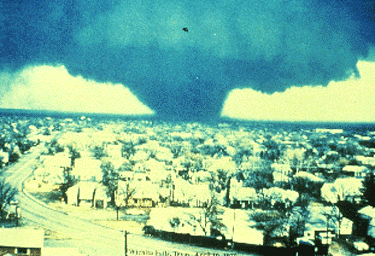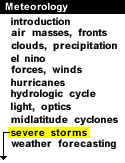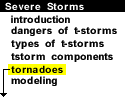
|
A tornado is defined as a violently rotating column of air in contact with the ground and pendent from a cumulonimbus cloud.

Photograph by: Marshall
They can be categorized as "weak", "strong", and "violent"; with weak tornadoes often having a thin, rope-like appearance, as exhibited by this tornado near Dawn, Texas. About 7 in 10 tornadoes are weak, with rotating wind speeds no greater than about 110 MPH. (looking west from about 1 mile.)
The typical strong tornado often has what is popularly considered a more "classic" funnel-shaped cloud associated with the whirling updraft. Rotating wind speeds vary from 110 to 200 MPH.

Photograph by: NSSL
Nearly 3 in 10 tornadoes are strong, such as this twister on the plains of North Dakota. Looking northeast (from about 2 miles), note the spiraling inflow cloud, probably a tail cloud, feeding into the tornado. An important safety consideration is that weak and strong tornadoes by definition do not level well-built homes. Thus, a secure home will offer shelter from almost 100 percent of all direct tornado strikes.
Only violent tornadoes are capable of leveling a well-anchored, solidly constructed home. Fortunately, less than 2 percent of all tornadoes reach the 200+ MPH violent category. Furthermore, most violent tornadoes only produce home-leveling damage within a very small portion of their overall damage swath. Less than 5 percent of the 5,000 affected homes in Wichita Falls, Texas were leveled by this massive 1979 tornado. (Looking south from 5 miles).

Photograph by: IDR
Note the huge, circular wall cloud above the tornado. This feature is probably close both in size and location to the parent rotating updraft (called a mesocyclone) which has spawned the violent tornado. Strong and violent tornadoes usually form in association with mesocyclones, which tend to occur with the most intense events in the thunderstorm spectrum.

Wall Clouds |
|

Useful Diagrams |




